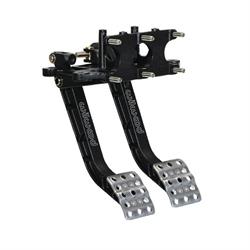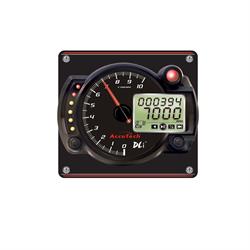Speedway's Wild '67 Camaro
You might look at this crazy, flamed cartoon come to life and wonder how in the world it came to be. In what kind of a rational universe does a perfectly good '67 Camaro get turned into a wild machine like this? If you're willing to check your sensible side at the door, the evolution and adventurous life of this old Camaro makes for a pretty good story.
Believe it or not, this car drove into our R&D shop as a basically stock Camaro with red paint and rally wheels. It belonged to our maintenance manager and had a hot 327 with a 4-speed. It was a cool car, and our plans were for a quick swap to our G-Comp front and rear suspension and back on the road as a test mule. Well, you know what they say about the best laid plans.
The Camaro sat in the shop collecting dust while two other G-Comp equipped rides went together; first a '65 Nova and then a '70 Camaro. Building and then campaigning those cars in autocross and road-racing events across the country taught us a whole lot about our products and what it takes to be competitive at the national level. With each event, we got smarter...and faster.
So it became clear that this car would have to be smarter, too. Brute, ham-fisted horsepower will only carry you so far in autocross. When the difference between a podium finish and a mid-pack also-ran is a few tenths of a second, every element of the car has to be playing in harmony. So we went to the drawing board and started brainstorming.
In fact, most of the trademark features of this car were decided upon in an impromptu morning cubicle meeting in the Speedway Motors engineering department. Someone had already rolled one of those large by huge 355/30ZR19 Kumho tires into the office; wouldn't it be cool to have those on all four corners? What about an independent rear suspension? Fifth-gen Camaro rears can be picked up at the junkyard, right? Aren't they too wide? What about a wheel with a huge backspace and some outrageous fender flares? Don't we have an old Kinsler fuel injection laying around somewhere? And on and on until the broad strokes for this wild machine had been settled on. Looking at the still stock Camaro shell sitting in the shop, clearly, we had our work cut out for us.
Now before you panic about us ruining a good Camaro, we can tell you that it really wasn't. First, it was rusty. When we got it back from the blaster, big chunks of Camaro were missing. Also, it was born as a six-cylinder grandma car. No big blocks or Rally Sports here, its original life was probably a pretty boring one.
With that said, this whole ground-up racecar thing got real in a hurry. One Monday morning we arrived to find that our fabricator had torched the whole floor out from the front seat to the back bumper. The pile of rubble and the enormous hole in the car made it clear that there was no turning back.
To fill the empty spaces, a 2011 Camaro rearend was pulled from its junkyard resting place and extensively modified with BMR arms, a G-Force Engineering Ford 9" center, upgraded halfshafts, and pushrod-actuated shocks designed in-house. This was all tied together by a custom frame assembly that extends from the rear bumper forward to the front subframe.
And what about that frontend? It looks a bit like a G-Comp or Unser unit pulled right from our shelves, but it's actually a full custom one-off that was developed to try out some new ideas that we had been dreaming up. First, the frame rails were pulled in towards the engine. This narrow package allows the giant tires to turn to a very respectable turning angle; very important in autocross. Another obvious deviation from the norm is the location of the steering rack. With the small centrifugal water pump mounted next to the oil pan, the rack was free to move right in front of the cam. This makes everything right with the bump-steer geometry and allows all the front-drive accessories to mount neatly to the aluminum motor plate. That plate also allows the engine to function as a structural member of the front subframe, stiffening the whole assembly.
The engine in question is a thing of beauty, and a whole article could be written about it alone. Speedway Racing Engines built it up using a Callies 3.875" stroke crank in an aluminum GM Bowtie block with a 4.130" bore, ending up with 421 cubic inches of displacement. Carillo rods swing CP pistons that yield a very angry 14.2:1 compression ratio. A Huggins solid roller cam actuates T&D shaft rockers on GM Bowtie 18-degree cylinder heads. An ARE pump circulates the slippery stuff from a Peterson tank that's hidden behind the passenger seat. It's all topped off with that wild magnesium Kinsler injector converted to EFI and managed by a F.A.S.T. computer. The whole thing looks (and sounds) like a big, angry sprint car engine ready to duke it out at 9,000 rpm.
The specs are cool, but the really intriguing part of this engine is its history. In the 90's, Speedway Motors was involved in racing at Pike's Peak and in the Indy Racing League. We were successful too, in 1994 a Speedway open-wheel car set a Pike's Peak record that stood for 20 years. You can watch the video of that run here. Notice who's behind the wheel? That's the one and only Robby Unser, the same guy who's been wheeling this Camaro for us. Now look closely at the valve covers on that engine. Look familiar? Yup, the same ones on the Camaro. The block, heads, intake, and those valve covers are all refugees of Pike's Peak and Indy Car battles from years ago. This is all coming full circle now, isn't it?
A McLeod clutch and a Tremec Magnum 6-speed sends the power to custom CCW wheels that measure 13" wide (!) with 10" of backspacing. Behind the wheels are 6-piston Wilwood calipers that clamp the floating Wilwood rotors. A Wilwood pedal assembly mounts the clutch and brake master cylinders under the dash, with remote reservoirs on the firewall for ease of service.
You may be surprised to learn that when you cram a 355-wide tire into a Camaro that's two inches off the ground you quickly run out of room. The obvious solution is to cover those meats with some giant fender flares. We looked to our in-house fiberglass shop to cook up some flares that we could tack on to the fiberglass fenders. We love purple here at Speedway, so the much-modified bodywork was covered in the new Mopar remix of Plum Crazy. And of course, we have to talk about the crazy graphics. Automotive artist extraordinaire Jeff Allison was called on to design the flame graphics that made the already wild looking Camaro into a full-on 1:1 scale toy car. Looks a bit like a model you might have excitedly kit-bashed together as a kid, doesn't it? Well, that was intentional.
Weight is the enemy when your car needs to start, stop, and turn in a hurry, so lightweight materials were used throughout. In addition to those fenders the hood, nose, rear bumper, and even the dash are fiberglass. The rear window is lexan along with the package shelf, making the pushrod-actuated AFCO 4-way adjustable shocks visible from above the car. Most of the interior is made from aluminum and is removable for easy service. This includes the rear floor, transmission tunnel, and door panels.
With all of this finally screwed together, we found ourselves staring at one of the wildest first-gen Camaros we had ever seen. Now the big question: will it work? We're happy to report that it works quite well, thank you. In its first full season campaigned by Team Speedway, the '67 made a few impressive appearances on the Goodguys AutoCross circuit, culminating in a big win at the Duel in the Desert in Scottsdale. This victory got Robby Unser and this Camaro crowned as the 2017 Autocrosser of the Year. It's also worth noting that this was the first non-Corvette to ever claim that title. Most recently, Robby and the '67 made a clean sweep of two shootouts and set fast time in the Pro Class at the Goodguys Street Machine Nationals in Columbus, Ohio.
So what's next for Speedway and it's purple Camaro? In addition to the constant effort of improving this flagship race car, we're also constantly applying what we're learning on the race track to the products that we sell. You may not want to go this far with your modified muscle car, but this knowledge and commitment to quality trickles down to everything we sell.
For more on our project cars and tech tips be sure to check out The Toolbox at speedwaymotors.com.






